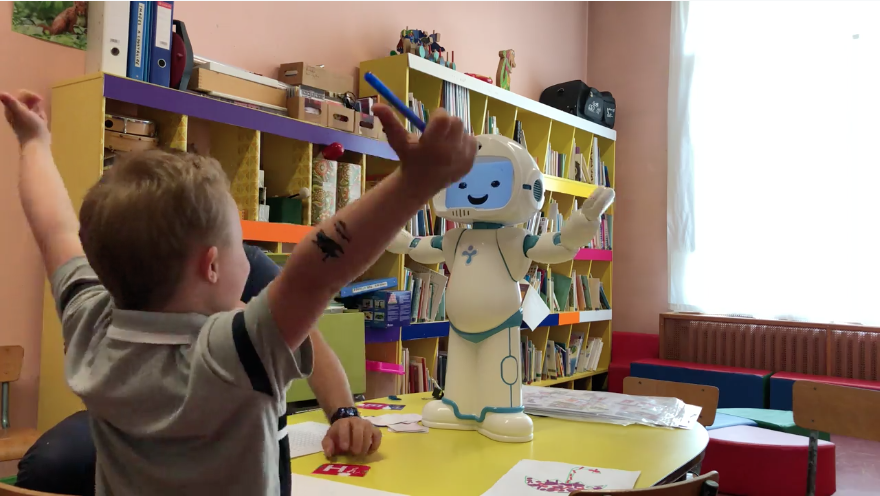By Shannon Flynn

People are increasingly interested in how robots can help humans. From manufacturing facilities and complicated surgical procedures to preventing loneliness among older people and other isolated individuals, the possibilities are endless. Another area of significant interest relates to how robots could supplement therapy for people with autism. This approach is a developing option, but it’s already proving its worth.
Encouraging Social-Skills Development
Learning how to interact with others can be challenging for anyone, but it’s often especially difficult for individuals with autism. They often need help recognizing emotions and responding to them appropriately.
Orbit is a robot that can provide this assistance. Ben Powell, a Loughborough University graduate who studied product design and technology, created the gadget after feeling inspired by his first-hand experience with autism. Powell noted how, as a child, he often struggled to correctly detect people’s emotions from their words.
The robot has a digital screen that doubles as a face. It tells stories to kids while displaying corresponding emotions on that component. As users touch and otherwise interact with the robot, they get ongoing feedback. People then get visual and audible responses to inappropriate social behavior.
Kids also learn about how their actions affect others. For example, if they press too hard on Orbit, the robot appears sad or scared.
Detecting How Kids Respond to Autism Therapy
Some therapies for kids with autism start when they’re 12 months old and continue from there. That’s why many parents may look for a robot for their children, hoping the gadget will make necessary therapy sessions more fun. Such innovations could also aid therapists in gauging the efficacy of specific methods and how clients respond to them.
Researchers from Istanbul Technical University created a robot called Kaspar that supports an artificial intelligence model for emotion recognition. The system also includes various smart sensors that record data about facial expressions, posture and eye movements. Together, these components reveal whether kids are happy, upset or feeling another way as they play with Kaspar.
Communication challenges often accompany diagnoses of autism. Robotic speech, repetition and uneven progress with speech and language skills are some aspects often seen, particularly in kids. If a child has trouble expressing how they feel, they’ll likely become increasingly frustrated during therapy sessions.
However, since the Kaspar robot aims to pick up on distress early, it can urge therapists to change their approaches accordingly. Then, children are more likely to have positive associations with therapy and be more receptive to it.
Improving Communication Capabilities
Since many robots designed for autism therapy speak, they can help people make meaningful communication gains. These gadgets provide helpful models for people to mimic.
The Milo robot for autism is one option used in Indiana school districts by about 3,000 to 4,000 participants. Milo speaks about 20% slower than people, a pace that facilitates learning. The humanoid-style robot also replicates most expressions people use while engaging with others. One fifth-grader who used Milo said the robot helped him learn to greet others and develop self-calming skills.
Rick Oslovar is a representative from RoboKind, the company that developed Milo. He recalled an instance where a formerly non-verbal student with autism could spend 20% of his time in a general-education classroom, answer a newscaster’s question and get ready for a birthday party after working with robots.
Monitoring a Child’s Engagement in At-Home Therapies
Researchers at the University of California realized some parents of kids with autism can’t afford or access therapy for various reasons. They knew robots should ideally support professional-led interventions, but that’s not always an option. The team responded by making Kiwi, a socially assistive robot.
Seventeen kids with autism participated in a study that involved playing space-themed games on a tablet while getting feedback from Kiwi. The researchers also used algorithms that personalized Kiwi’s responses and the games’ difficulty levels according to how the children engaged. The team tried to maximize the game’s challenges without making the youngsters feel frustrated.
At the end of this month-long intervention, all kids had improved math skills, while 92% had better social capabilities, too. The researchers also got valuable takeaways that could shape further work concerning robots and autism. For example, they found kids were more engaged when Kiwi had spoken within the previous minute than if the robot stayed silent for longer.
An Exciting Future for Autism Therapy
The people building machines and applications for robots in autism therapy primarily focus on kids. However, that could change, especially if real-world tests show these innovations have additional benefits for older age groups.
Most developers stress that robots must complement therapist leadership and oversight during sessions rather than replacing these professionals. As the last example illustrates, these smart machines might fill in gaps between scheduled visits or support parents without access to therapists. In any case, there’s a lot to look forward to as we wait and see what kind of further progress occurs in these efforts.
About the Author Shannon@rehack.com

